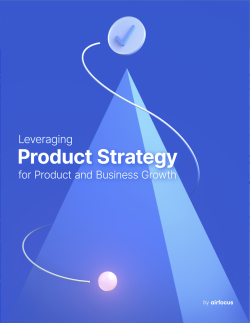Product Vision
What is a Product Vision?
Product vision definition
A product vision aims to describe the future state of a product. It is the core essence of the product. Ideally, the product vision will serve as a guide for the stakeholders, as it will remind them of the general direction the product should be taking, and the common objectives within the team.
Basically, the product vision is a statement of ambition that underpins the whole project. The concept allows you to define how the final product should function, who it’s being built for, and how it will address their needs. The product vision should serve as a guide for stakeholders, allowing them to understand the product's general direction and common team objectives.
The benefits of a product vision
With a product vision statement, roadmapping becomes a lot easier, too. If you start with a clearly defined vision, you can translate that vision into an action plan.
Once you have an action plan, you can break it down even further and develop a comprehensive development plan.
All-in-all, product vision gives direction, and motivation, and makes prioritization a lot more simple.
Who writes the product vision statement?
A common misconception is that the product owner should be responsible for the vision statement. While the product owner should take ownership of the vision statement, it’s not solely up to them to create it.
The vision statement isn’t a static document and it will change throughout the development process. With that in mind, all parties involved in development must be able to offer input on the product vision statement.
Everyone in the company can have a say in what goes into the vision statement, from development teams to higher-ups. This ensures that the vision contains as many value-adding ideas as possible while still maintaining company values.
How to write a product vision statement?
The product vision statement should ensure complete alignment and clarity throughout the development teams, stakeholders, and other relevant parties. Follow these four principles to achieve this:
Customer-focused: The vision statement needs to focus on the value the product will offer to customers.
Ambition: Your product vision statement should be ambitious. You don’t want to put out a medium-quality product — you want to change the game!
Differentiation: Your product vision statement should make it clear how this product will give your company an edge over its competitors.
The future: What do you want people to think about your product in the future? What legacy should this product aim for?
As long as you refer to these principles in your product vision statement, you should be ready to start development.
Examples of product vision statements
All of the biggest brands around the world have developed a product vision statement. Here are some of the more popular ones:
Amazon - To be Earth's most customer-centric company, where customers can find and discover anything they might want to buy online.
Apple - To bringing the best user experience to its customers through its innovative hardware, software, and services.
Disney - To be one of the world's leading producers and providers of entertainment and information.
LinkedIn: To connect the world’s professionals and make them more productive and successful.
Instagram: To capture and share the world’s moments.
Microsoft Surface: Unlike laptops, Surface serves your on-the-go needs without having to carry an extra device.
Sonos: Fill every home with music.
Google: To provide access to the world’s information with one click.
As you can see, each product vision statement above clearly defines the direction each brand is taking with its product or service. Each one focuses on their desire for the future state of their product, and their common objective is always to make decisions that bring them closer to that state.

When do you need a product vision?
It is important to start a new product with a vision.
It is very likely, however, that the product vision will be tweaked or even completely changed over time.
Regardless of the industry, product, and team, a new product should always start with a clearly defined vision statement.
How do product owners contribute to the vision?
Product owners need to own the product vision.
The vision is the guiding star to success, the measure against which the final product will be judged.
Because product owners are responsible for the product's success, managing, communicating, and championing the product vision are three of the most important things that a product owner can do.
Product owners also need to be flexible enough to allow the product vision to change. They must make sure that the product vision accurately reflects other stakeholders' requirements when they change.
End users and team members also often have valuable feedback that product owners should consider.
If the feedback is useful, it can be incorporated into the product vision, but owners are also gatekeepers, ensuring that the product vision stays clear and free of distractions.
Product owners need to constantly communicate the product vision to stakeholders, teammates, and users.
Keeping the vision front and center fixes everybody’s eyes on the end target, heading in the same direction. Sharing a clear product vision also helps teams align and make decisions that add the most user value.
What happens after we have achieved product vision in agile?
In agile, a product vision answers the following questions:
What is the product?
Who is the primary market for the product?
Why does the primary market need the product?
How will the product benefit its primary market?
What differentiates the product from its competitors?
When the product owner has considered these questions, the stakeholders have agreed on metrics that define success, and then the team has created the product, but the product owner’s job isn’t finished. It's time to start reviewing.
First, the stakeholders need to evaluate the product against the established metrics. Does everyone agree that the product adequately meets the agreed standards?
If yes, it’s time to celebrate your success, but then consider whether your product vision has room to grow. Alternatively, it may be time for a new product altogether — including a new product vision.
If not, depending on how much development is needed, it’s time to plan new iterations of your epic, theme, or initiative. Review the stories, the product vision, and the metrics to define and prioritize the product needs. Then create a plan that iterates your product until it matches the product vision.
Your first next step: Write a product vision statement
The product vision statement is a document that describes the crucial, overarching, and long-term mission of your product. Your vision statement should also answer the question of why you are creating a product and what your company hopes to accomplish with it in the future.
Essentially, you’re defining the reason why this product is worth making, who it will benefit, and how it will benefit them. Vision statements are aspirational, so there’s no need to go into technical detail at this stage. You just need to concisely communicate where the business hopes the product will go and what they hope it will achieve in the long term.
A product vision statement intends to serve as a source of truth that will guide development. It also acts as a reminder to all stakeholders involved in a product’s development (the product team, development, executive staff, marketing, etc.) about the shared objective they’re aiming for with this product.
How to write a product vision statement
Getting your product vision statement right is crucial if you want to ensure complete alignment and clarity throughout the development teams, stakeholders, and other relevant parties. To achieve this, you need to make sure your product vision board includes the following 4 principles:
Customer-focused: You’re not building this product to sit unused in a vault somewhere. You’re building it for your customers, new and old. Your product vision statement needs to clearly represent this and focus on customer needs.
Ambition: You don’t need to shoot for the moon, but your product vision strategy should aim to go above your team’s current abilities. If you push your team a little extra on each project, they gain personal improvement while your deliverables become better and better,
Differentiation: Your product vision statement should make it clear how this product will give the company an edge over its competitors.
The Future: What do you want people to think about your product in the future? What legacy should this product aim for?
Now, the product vision statement doesn’t need to explicitly state all of these things, but it should make these points clear.
Using a product vision template
If you’ve never written a product vision statement before, then a tried-and-tested template can be useful to get the process started.
A basic product vision template might look like this:
This a product for…
Who needs to…
The [product name] is a [product category]
That [benefit delivered by the product]
Unlike [your primary competitor]
Our product [your USP or primary differentiating feature]
Filling in the blanks above should help shape your product vision statement, but remember, the product vision statement is the cornerstone of your product strategy. It will inspire your team, inform your roadmap and even affect day-to-day decision-making, so product managers need to take the appropriate amount of care while writing and crafting the product vision statement.

You may also need to return to your product vision board, template, or statement as the competitive landscape changes or as your users’ needs evolve.

General FAQ

Glossary categories
Create effective product strategy

Experience the new way of doing product management








